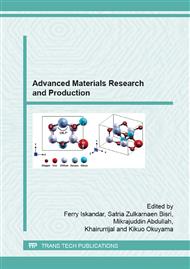[1]
K. S. Novoselov, A. K. Geim, S. V. Morozov, D. Jiang, Y. Zhang, S. V. Dubonos, I. V. Grigorieva, and A. A. Firsov, Electric field effect in atomically thin carbon films, Science 306 (2004) 666-669.
DOI: 10.1126/science.1102896
Google Scholar
[2]
M. I. Katsnelson, K. S. Novoselov, A. K. Geim, Chiral Tunnelling and the Klein Paradox in Graphene, Nature Phys. 2 (2006) 620-625.
DOI: 10.1038/nphys384
Google Scholar
[3]
L. Brey and H. A. Fertig, Electronic states of grapheme nanoribbons, Phys. Rev. B 73 (2006) 235411-1/5.
Google Scholar
[4]
Y. W. Son, M. L. Cohen, and S. G. Loui, Energy Gaps in Graphene Nanoribbons, Phys. Rev. Lett. 97 (2006) 216803-1/4.
DOI: 10.1103/physrevlett.98.089901
Google Scholar
[5]
B. Huang, Q. Yan, Z. Li and W. Duan, Towards graphene nanoribbon-based electronics. Front. Phys. China 4 (2009) 269-279.
DOI: 10.1007/s11467-009-0029-3
Google Scholar
[6]
Q. Zhang, T. Fang, H. Xing, A. Seabaugh and D. Jena, Graphene nanoribbon tunnel transistors, IEEE Electron Device Lett. 29 (2008) 1344-1346.
DOI: 10.1109/led.2008.2005650
Google Scholar
[7]
C. S .P. Bimo, F. A. Noor, M. Abdullah, Khairrurijal, A Theoretical Model of Band-to-Band Tunneling Current in an Armchair Graphene Nanoribbon Tunnel Field-Effect Transistor, Adv. Mater. Res. 896 (2014) 371-374.
DOI: 10.4028/www.scientific.net/amr.896.371
Google Scholar
[8]
P. Zhao, J. Chauhan, J. Guo, Computational Study of Tunneling Transistor Based on Graphene Nanoribbon, Nano Lett. 9 (2009) 684-688.
DOI: 10.1021/nl803176x
Google Scholar
[9]
F. Liu, X. Liu, J. Kang and Y. Wang, http: /www. arxiv. org (2013) 13123391-1/3.
Google Scholar
[10]
W. Z. Shangguan, X. Zhou, S.B. Chiah, G. H. See, K. Chandrasekaran, Compact gate-current model based on transfer-matrix, J. Appl. Phys. 97 (2005) 123709-1/4.
DOI: 10.1063/1.1929885
Google Scholar
[11]
B. Huang, Q. Yan, G. Zhou, J. Wu, F. Liu, B. L. Gu, W. Duan, Making a field effect transistor on a single graphene nanoribbon by selective doping, Appl. Phys. Lett. 91 (2007) 253122-1/4.
DOI: 10.1063/1.2826547
Google Scholar
[12]
J. Knoch and J. Appenzeller, Tunneling phenomena in carbon nanotube field-effect transistors, Phys. Status Solidi A 205 (2008) 679–694.
DOI: 10.1002/pssa.200723528
Google Scholar
[13]
E. Suhendi, R. Syariati, F. A Noor, N. Kurniasih, Khairurrijal, Simulation of Dirac Tunneling Current of an Armchair Graphene Nanoribbon-Based PN Junction Using a Transfer Matrix Method, Adv. Mater. Res. 974 (2014) 205-209.
DOI: 10.4028/www.scientific.net/amr.974.205
Google Scholar
[14]
D. K. Ferry, S.M. Goodnick, J. Bird, Transport in Nanostructures, Second Ed., Cambridge University Press, Cambridge, (2009).
Google Scholar


